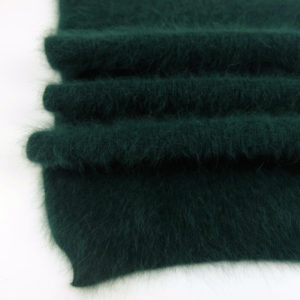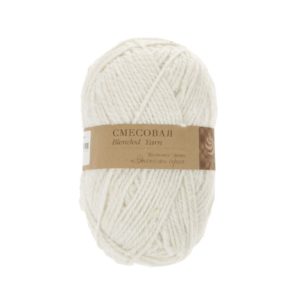Wool is a natural material that retains heat perfectly. It is combed from animals and made into yarn, which subsequently serves as the basis for the production of clothing.
What does “wool blend” mean?
 This is a combination of natural and synthetic fibers, a durable, lightweight and elastic airtight material. Such products do not deform when washed, do not shrink and retain the brightness of colors.
This is a combination of natural and synthetic fibers, a durable, lightweight and elastic airtight material. Such products do not deform when washed, do not shrink and retain the brightness of colors.
Why are other components added to wool?
Artificial or herbal supplements eliminate the following disadvantages:
- formation of pellets;
- fabric stretching;
- material shrinkage;
- high cost of the product.
How do they do it?
To obtain blended yarn, various fibers are combined with each other to produce a unique material with greater hygroscopicity, strength and air tightness.
Advantages and disadvantages of wool blends
 Yarn made from several types of fibers is good because it combines the positive qualities of various materials. A pure wool item can pill, stretch, and shrink. Adding other ingredients, both natural and artificial, can neutralize these problems.. The addition of synthetics protects the finished product from deformation and helps maintain the brightness of the colors.
Yarn made from several types of fibers is good because it combines the positive qualities of various materials. A pure wool item can pill, stretch, and shrink. Adding other ingredients, both natural and artificial, can neutralize these problems.. The addition of synthetics protects the finished product from deformation and helps maintain the brightness of the colors.
A great option would be to combine several types of natural fibers with synthetic ones. The products combine the maximum of the best properties of the constituent materials.
The combination of natural fibers can also become a disadvantage, for example, when dyeing a finished product made from wool mixture. Due to the fact that cotton and wool absorb paint differently, it may lie unevenly.
Types of wool blend compositions
 Sheep wool with acrylic or viscose in the composition of the material indicates its low price and the same quality. Products made from such a mixture will soon become covered with pellets and lose their appearance.
Sheep wool with acrylic or viscose in the composition of the material indicates its low price and the same quality. Products made from such a mixture will soon become covered with pellets and lose their appearance.- The combination with cotton creates a high-quality and popular material - wool blend. It is soft, durable and smooth, great for people with sensitive skin and children. Products made from such yarn are not as prickly as wool products without additives.
- Cashmere with sheep fiber is the noblest combination; products made from it are distinguished by their tenderness and lightness, and retain heat perfectly.
- Silk prevents the formation of pilling by combining with wool fibers. The canvas is durable, does not lend itself to deformation and is easy to paint.
Types of blended yarn
The classification and functionality of wool products directly depend on the fibers from which the material is made:
 alpaca is a yarn made from the wool of South American llamas.It does not pill, comes in 22 color shades, is extremely rarely mixed with other materials and has a high price;
alpaca is a yarn made from the wool of South American llamas.It does not pill, comes in 22 color shades, is extremely rarely mixed with other materials and has a high price;- Angora is a light, soft and warm yarn made from combed or sheared fluff of the Angora rabbit. It lends itself perfectly to dyeing in a variety of colors, most often it is mixed with sheep fiber, synthetics or silk;
- camel wool is a durable and lightweight material that perfectly retains heat, has 14 natural shades;
- Cashmere is the down of wild mountain goats, combed and sorted into fibers. Products made from it are warm and light, and if handled correctly, are durable. Pure cashmere is extremely rare; a mixture of it with sheep wool or silk is common.;
- mohair is the fluff of young Angora goats; the younger the animal is, the more valuable the material. Their mohair yarn is soft, fluffy and durable, with a characteristic shine. It is not produced in its pure form; combinations with nylon, sheep wool or silk are most relevant;
- merino yarn is light and very thin, rarely mixed, since the only advantage of the mixture is the reduction in the cost of the product;
- Sheep wool is the most popular; the quality indicator is the fineness of the thread. It can be used either in its pure form or mixed with more expensive materials to reduce their cost and make them durable.
What is knitted from mixed yarns?
A combination of different fibers is used for:
- production of warm winter clothing;
- making summer things.
 Merino and sheep wool make wonderful pullovers and shawls. Light and warm sweaters with a variety of patterns are knitted from wool blend - yarn with a wool content from 8 to 52%. Sweaters and cardigans are also knitted from a mixture of cashmere and sheep fiber or silk.
Merino and sheep wool make wonderful pullovers and shawls. Light and warm sweaters with a variety of patterns are knitted from wool blend - yarn with a wool content from 8 to 52%. Sweaters and cardigans are also knitted from a mixture of cashmere and sheep fiber or silk.
Mohair is most often mixed with silk to make pullovers and cardigans. Sweaters and ponchos are knitted from yarn mixed with angora. For the production of dresses and jackets, alpaca is popular in combination with sheep, merino or acrylic thread.
The strength of a product depends on the number of threads in the yarn: the more there are, the stronger the item. The more tightly the thread is twisted, the less prone the product is to pilling, but air retains heat better.


 Sheep wool with acrylic or viscose in the composition of the material indicates its low price and the same quality. Products made from such a mixture will soon become covered with pellets and lose their appearance.
Sheep wool with acrylic or viscose in the composition of the material indicates its low price and the same quality. Products made from such a mixture will soon become covered with pellets and lose their appearance. alpaca is a yarn made from the wool of South American llamas.It does not pill, comes in 22 color shades, is extremely rarely mixed with other materials and has a high price;
alpaca is a yarn made from the wool of South American llamas.It does not pill, comes in 22 color shades, is extremely rarely mixed with other materials and has a high price; 1
1





